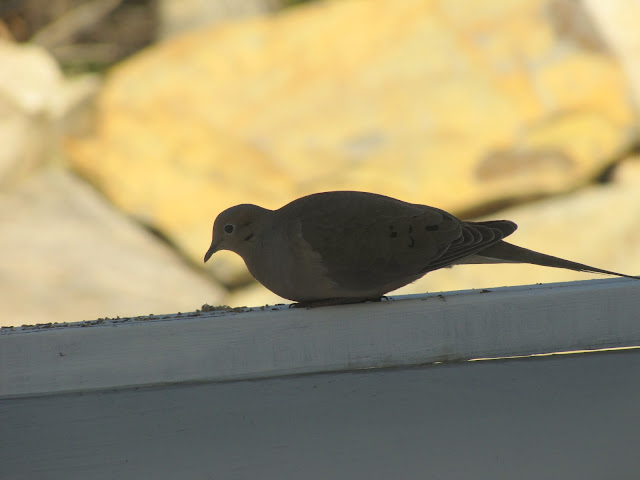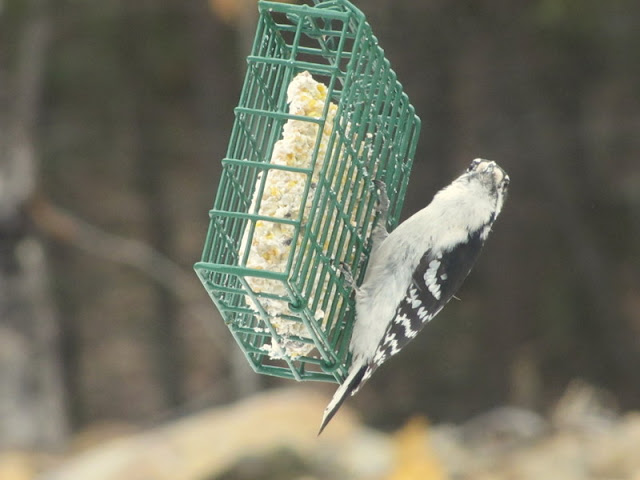The second thing I want to address is that we are novices; this it the very first time my husband and I have done sheet mulching in our garden and we really have no idea if it is going to work out as wonderfully as we imagine it is going to. So when you read through this step-by-step as you are making your own garden, just remember that this is by no means written by an expert or even by someone with experience. I have taken a lot of time to read through Gaia's Garden, Lasagna Gardening and a handout I got from a permablitz I participated in (where we assembled raised beds and filled them lasagna gardening style) to gather all the information I needed to assemble or garden. According to all theses sources, our garden should be brilliant. Even so, I feel obligated to warn you.
Finally, the ingredients I've used in our lasagna garden certainly not the only things that can and should be used in your garden. One of the benefits of creating a lasagna garden is that you can be creative with ingredients based on what you have access to. So, after I go through the steps on how we made our personal garden, I will briefly list suggestions I've found from my sources of other materials that you may consider using. Don't worry, lasagna gardening is very forgiving, you just have to keep a couple things in mind and I'll address those at the end of the post.
So now, without further ado, here is how we assembled our very own raised beds.
1. Choose a location and test the soil. We bought a cheap and quick soil testing kit off of amazon. I've heard that theses tests aren't always accurate for anything besides there pH test, which was fine with me because that's all I was really interested in. I figured we would be making our soil from all sorts of goodies and the rest of the results didn't matter as much. I did two pH tests to make sure I got similar results, and both bordered around neutral. If it had been acidic, I would have added lime as my first ingredient to our beds. If it had been too alkaline, I probably wouldn't have added anything because I guess composting and mulching help alleviate that problem. I've read you can add sulfur if you really want to lower that pH.
2. Assemble the raised beds. You can be creative with shapes and materials here. We thought about making a big keystone bed, but it was too complicated with wood and rocks would be too expensive. So we decided to make traditional rectangular beds. If you make a rectangular bed, make sure that it is only 3-4 feet across so you can reach into the middle of the bed without stepping into it. We made 6 beds all measuring 4x10 feet. The beds need to be at least 6 inches deep; 10-12 inches if you plan on planting lots of root vegetables or have very poor initial soil. Our boards are all 12 inches wide. We used cedar boards, which are ideal as cedar is very rot resistant. You do not want to use treated lumber because the chemicals will interact with your soil (and your food!). Other, less expensive non-treated lumber may be okay but eventually they may rot and fall apart. So if you are thinking long term, go with cedar. The only other thing to note is that you should use either stainless steel or coated outdoor screws. These will prevent them from rusting into your bed and all over the frames once they get wet. Once the beds are assembled, place them where you plan on keeping them. Make sure you leave paths in-between. You can get away with foot wide rows, but we went with two-foot wide rows so that we had plenty of squatting room and for the wheel-barrel to go through. Finally, you need to make sure your raised beds are level.
3. Add trace minerals. We used a compound called Azomite.
Azomite is a natural product mined from an ancient mineral deposit in Utah (USA) that typically contains a broad spectrum of over 70 minerals and trace elements, distinct from any mineral deposit in the world. Azomite is used internationally as a feed additive and a soil re-mineralizer for plants. Azomite trace minerals have been reported to improve root systems, yields and general plant vigor in a variety of field crops and garden vegetables. Available for a variety of applications, Azomite can be used to remineralize nutrient-depleted soils and is OMRI Listed for certified organic production.I found out very recently that a local alternative (since Azomite needs to be shipped from Utah) is to contact quarries and ask for granite dust. At this point, you also want to loosen up the sod a bit just be poking at it with a hoe. Don't till it (scoop up and turn the soil), you just want to open up the sod a bit. We didn't bother with this step because the sod got broken up when we leveled the beds and we didn't have much grass to begin with.
4. Sprinkle on a little layer of manure. This will help to encourage all the invertebrates you need to come up and compost to your lasagna garden to make their way up to the surface. Water your plots after this (and every step).
5. Put down a weed block layer. This can be lots of wet newspaper, or if you have a very weedy are use cardboard boxes. Make sure you don't use the shiny newspaper pages and to take off all the tape and staples from boxes. You do not want any bare earth exposed, so fill in the gaps well, and be sure to cover all of your paths too. When you are done, soak the paper/newspaper down well.
 |
| Filling in gaps |
6. Make your beds level. You should have already done this once, but adding the cardboard may have shifted things and from now on they shouldn't really be moving. You may need to stack extra boxes under certain sides to get them level. This is important because raised beds are very good at holding water, and if they aren't level that water is going to pool all on one side.
7. Add an inch or two of rotted manure. We are fortunate enough to have friends who own horses and were able to get a truck load of 1.5 year old manure. It is perfect. Water well!
8. Add several inches of chopped leaves. We borrowed a leaf blower from our parents and used that to chop bagfuls of leaves at a time. Since we didn't do this ahead of time, this actually ended up being the most time consuming step. We put in 4 bags of chopped leaves into each bed. Then watered well!
9. Add a layer of seaweed. A friend of mine helped me to collect a 20 gallon bucket full of rockweed that washed up on the shore. You should not harvest live seaweed, as this practice is unsustainable and damages the ecosystem. Rather, you should try to collect freshly washed up seaweed from the shore after a storm. You don't want dried up and rotting seaweed. Make sure when you bring it him you wash it with sweet-water, otherwise the salt will leach all the nutrients from your soil. I just used one bucketful divided among 6 beds, but really I should have used a bucketful in each. Make sure to water this layer too.
10. Add a couple inches of peat moss. This is a great step forward to creating a nice humus layer in your garden. Peat moss can absorb tremendous amounts of water. It's easiest to work with if you get it wet first, otherwise it's like dust and flies everywhere. Water this layer very well.
11. Add an inch or two of compost. The only compost we have at home is the ones in our worm bin. There was not nearly enough compost in there to spread over the six beds. So instead we had to go out and buy some. We ended up buying 12 sq foot bags of Coast of Maine compost (6 bags of the Quoddy Blend Lobster compost and 6 bags of the Shoodic Blend Cow Manure Compost). The Coast of Maine brand is fantastic as it is all organic and made locally. We spread one bag of each type onto each bed, then watered.
12. Our last layer was another weed-block layer. Here you can use straw if you want or bark mulch. We chose to buy the Dark Harbor Blend Enriching Mulch made by the coast of Maine. It is a very fine mulch that doesn't rob plants of nitrogen (as many mulches do) yet still able to maintain moisture and insulate the soil. I especially liked using this mulch because I think it will be much easier to start seeds in then a thick layer of straw. Be sure to water well.
13. Mulch the paths. Initially we planned on using the bark mulch on the paths too, but this year it was not in our budget so we went with the less expensive option of straw. If you go this route keep in mind that you want to use either straw or rotted hay, as hay will sprout and give you lots of weeds which defeats the purpose.
14. Finally, if you assembled your raised beds in late winter/early spring like we did, you might want to put down plastic over the beds to "cook" them. The black plastic will soak in the sun's rays and help the garden to heat up and start to compost more quickly. If you do this for about 6 weeks, supposedly you will have some pretty decent soil to work with.
So there you have it: how we made our very own lasagna gardens. We had hoped to fill them up to the brim, but we were pretty limited in free resources, and are struggling financially so we had to just do our best and hope it is good enough. In future posts I will talk about what we are planting and where, and other interesting things like that. But for now I will end this post with a note about other materials you can mulch with if the materials we used aren't readily available to you.
Lasagna gardening is supposedly very forgiving and you can use a whole bunch of ingredients or just a couple and it should work just fine. The only thing you should keep in mind is that you want to keep between a 100:1 and 30:1 Carbon to Nitrogen ratio. According to Hemenway in Gaia's Garden:
In general, Green materials, such as grass clippings and fresh plant trimmings are high in nitrogen. Brown items, such as dried leaves, hay, straw, and wood shavings, are high in carbon. The exception here is manure, which although brown, is high in nitrogen. Mixing roughly half green with half brown approximates the ideal C:N ratio (Hemenway pg. 83).
If high-nitrogen materials are scarce, sprinkle in some bonemeal or blood meal. Here are some mulching materials you might consider divided into Carbon and Nitrogen rich categories:
Nitrogen Rich
Clover
Compost
Fish scraps
Grass clippings
Manure
Seaweed
Fresh Hay (only use in deep layers so it doesn't sprout weeds)
Salt Hay
Carbon Rich
Dried Leaves
Hay
Sawdust
Straw
Grain hulls
Wood ash
Peat Moss
Wood shavings
Most importantly though, remember that there are many ways to go about sheet mulching, these are just suggestions I've gathered from my research. Have fun, be creative, and experiment! Hopefully our experiment works out okay this year!




















































